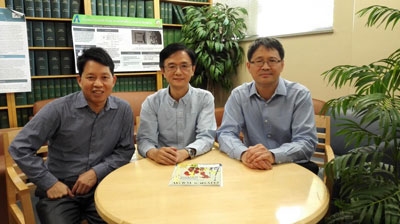| Posted: Aug 05, 2016 |
New project to develop new device that delivers photo-induced cancer therapy
(Nanowerk News) Physicists from The University of Texas at Arlington are leading a multidisciplinary project with The University of Texas Southwestern Medical Center in Dallas and The University of Texas MD Anderson Cancer Center in Houston to develop a new multifunctional platform that can integrate imaging and photo-induced cancer therapy in a single, portable device.
|
|
The process of destroying cancer cells by utilizing chemicals or heat generated by nanoparticles induced by near-infrared light - through processes including photodynamic therapy and photothermal therapy - has shown great promise as a treatment option, along with surgery, radiation therapy and chemotherapy. Photo-induced therapies are minimally invasive and cell destruction occurs only locally at tumor sites.
|
|
Scientists believe that a real-time, tumor-guided therapy device, which can perform imaging and therapy simultaneously, will further improve the outcome of photo-induced therapies for patients. Recent studies have shown that it is possible to incorporate some imaging reporters to the nanoparticles used in photo-induced therapies.
|
|
"Presently, the simultaneous cancer imaging and treatment of these nanoparticles is not possible due to the lack of a multifunctional device," said Mingwu Jin, UTA assistant professor of physics. "Our idea is to take an image of the tumor and then use that image to guide the physician where to focus the laser to deliver the therapy, while minimizing the damage to surrounding tissue."
|
 |
| From left: Wei Chen, UTA physics professor; Mingwu Jin, UTA assistant professor of physics and leader of the project: and Liping Tang, professor of bioengineering.
|
|
The National Institutes of Health awarded a $415,336 grant to Jin for a three-year project titled "Boosting photo-induced cancer therapies through real-time image guidance." Jin is joined by UTA physics professors Jaehoon Yu and Wei Chen, and Liping Tang, professor of bioengineering.
|
|
Li Liu, assistant professor, Xiankai Sun, associate professor, both in radiology at UT Southwestern, and Chun Li, professor of diagnostic radiology at MD Anderson Cancer Center, are also collaborating on the project to provide expertise on cancer cell biology, preclinical nuclear imaging, and radio-chemistry.
|
|
Previously, portable imaging probes utilizing gamma rays and beta particles have been used, but each of these comes with technical hurdles, which have not allowed for the integration of simultaneous imaging and therapy in a single, portable device.
|
|
Jin and his colleagues plan to use the position-sensitive gas electron multiplier detector available in UTA's high energy physics lab and advanced spatiotemporal image processing to enable real-time image guided photo-induced therapies. The end goal is to develop a multifunctional device which they call Beta Image Guided Light-Induced Therapeutic dEvice or BIGLITE.
|
|
"Gas electron multiplier or GEM-based devices have many advantages," Jin said. "In additional to its excellent detection performance, the flexibility of GEM can be used for a miniature device with the easy integration of an near infrared fiber for therapeutic purposes. Although GEM technology is rapidly evolved and widely used in high energy physics experiments, to directly detect beta particles in a miniature setup requires significant research and innovative designs which will be carried out as part of our project."
|
|
Jin added that the team will apply spatiotemporal processing strategy for BIGLITE with the aid of optical imaging of visible light. A miniature digital camera will be integrated and synchronized with beta imaging to track the position and motion of BIGLITE related to the area of interest. The beta image frames can be enhanced through motion-compensated spatiotemporal processing to achieve a high frame rate to enable the real-time image guided near-infrared light delivery.
|
|
The researchers believe that their proposed BIGLITE device can significantly improve the efficacy and safety of photo-induced therapies and shorten treatment time for patients in a number of ways.
|
|
"First, image-guided near-infrared laser delivery can precisely kill cancer cells while sparing healthy ones," Jin said. "Second, due to this precise laser delivery, the laser power can be significantly increased so that more photon energy can be converted to chemical or thermal energy in a unit time for a faster tumor destruction. Third, this increased laser power can be utilized to lower the nanoparticle treatment dose for less toxicity."
|
|
Given that tumors are increasingly being detected at an earlier stage and the proportion of elderly patients is increasing, BIGLITE's ability to enable the "seek and treat" strategy will become increasingly important for photo-induced therapies as a minimally invasive and effective treatment option for a broad spectrum of cancers, Jin said.
|
|
Morteza Khaledi, dean of the College of Science, said that the project is a prime example of the important collaborative research being done at UTA and reflects the University's emphasis on health and the human condition, one of the four main pillars of UTA's Strategic Plan 2020: Bold Solutions | Global Impact.
|
|
"This project has tremendous potential to introduce a safer, faster, more efficient method of providing treatment for cancer patients," Khaledi said. "The research being done by Dr. Jin and his colleagues demonstrates again that we are committed to finding solutions to pressing medical issues which affect the health of so many people."
|
|
Chen's role in the project is to provide copper sulfide nanoparticles to use in testing with the BIGLITE device. In 2010, Chen led a team which first developed copper sulfide nanoparticles for use in photothermal therapy to remove cancer cells. Due to their unique optical properties, small size, low cost of production and low toxicity to cells, Chen and his colleagues found the copper sulfide nanoparticles to be promising nanomaterials for use in photothermal therapy.
|
|
Yu will provide the assistance on hardware development using GEM and Tang will help design studies to test the efficacy of the BIGLITE therapy.
|

